Video conference notes 24 April 2014 - Marine wildlife
SWIFFT video conference notes are a summary of the video conference and not intended to be a definitive record of presentations made and issues discussed.
This video conference was supported through resources and technology provided by the Department of Environment and Primary Industries, Victoria. SWIFFT also wishes to thank speakers for their time and delivery of excellent presentations.
A total of 52 participants were connected across 12 locations; Ararat, Ballarat, Bairnsdale, Bendigo, Colac, Geelong, Hamilton, Heidelberg (Arthur Rylah Institute), Heywood, Horsham, Melbourne (Nicholson Street) and Orbost.
Preliminary list of groups/organisations in attendance;
Educational: Deakin University, Bendigo TAFE
Local Government:
Field Naturalist Clubs: Ballarat, Geelong, Hamilton.
Community Conservation Groups: Windamara Aboriginal Corp.,
Conservation Organisations: Parks Victoria, Bellarine Bayside Committee of Management, Barwon Coast Committee of Management, Western Coastal Board, Blue Whale Study Org., Dept. of Environment and Primary Industries staff across 11 locations, inc. Nicholson Street Melbourne and Arthur Rylah Institute, Heidelberg.
Industry: Deliberate Impact, consulting arm of Conservation Enterprises Unlimited.
Speakers
Conservation of Leatherback turtles - Patrick O'Callaghan, Director of Deliberate Impact, consulting arm of Conservation Enterprises Unlimited.
Endocrine disturbance in a population of Australian fur seals with a high prevalence of alopecia - Michael Lynch, Head of Veterinary Services, Melbourne Zoo
Blue whales in the Bonney upwelling - Peter Gill Co-Director, Blue Whale Study Inc.
KEY POINTS SUMMARY Quick take home messages from this video conference or read through the speaker summaries.
SPEAKER SUMMARIES
Conservation of Leatherback turtles - Patrick O'Callaghan, Director of Deliberate Impact, consulting arm of Conservation Enterprises Unlimited.
Patrick spoke about his experiences with leatherback turtle programs overseas, particularly when he was working in Canada. He described the world wide distribution of leatherbacks which have been recorded in almost every part of the world's oceans except Antarctic waters and off Greenland.
Leatherbacks call Victoria home
Despite their historically wide distribution Leatherback Turtles remain unknown to most people as they have never seen or heard about this species and don't realise that these turtles inhabit our waters. Unfortunately, in Victoria most encounters are of dead leatherbacks, either entangled in fishing gear or washed up dead on beaches.
Patrick emphasised that leatherbacks in Victorian waters should not be considered unusual as it is part of their natural range where they come to feed on jellyfish and tunicates, although breeding is carried out in tropical waters to the north of Australia.
Example conservation program in the Northern Hemisphere
Patrick spoke about his experiences in Vancouver, Canada whilst working on marine conservation programs. He noted there was a similar lack of community understanding about leatherbacks in that part of the world as well.
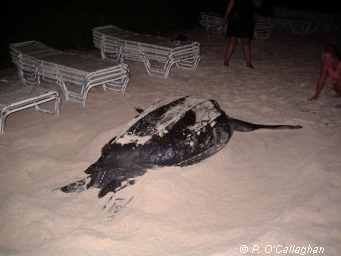 |
| Leatherback Turtle nesting at tourist beach in Mexico
|
Patrick became involved with a collaborative project through the Commission for Environmental Cooperation (CECC) set up through the North American Free Trade Agreement. This provided an avenue to collaborate with people in Mexico where there are important nesting areas for leatherbacks which migrate to feeding areas in southern Canada.
A collaborative project to conserve nesting sites and hatchlings was set up at selected sites in Mexico. Many of the sites were located in highly populated areas where there is a lot of human activity, particularly where there are hotels and tourism activities built close to nesting sites.
The value of leatherback nesting has become a means of enhancing tourism through managing important nesting sites and hatchling programs where tourism operators can gain economic benefits whilst also ensuring eggs and hatchlings are protected.
A campaign to reduce the appeal of eating turtle eggs as an aphrodisiac has also been undertaken in Mexico.
Major impacts on Leatherback Turtles
Commercial fishing entanglements.
Loss / disturbance to nesting sites.
Management
Turtle exclusion devices - in trawl nets.
Implementation of a long line circle hook to reduce by-catch in the waters off Hawaii
Leatherback lift - equipment fitted to fishing boats to assist the removal of entangled turtles from the water for detangling and release.
Decline of nesting populations
Patrick discussed the significant decline in nesting populations around the world. He showed a graph depicting decline in the eastern Pacific (Central American populations) between 1988 - 2009.
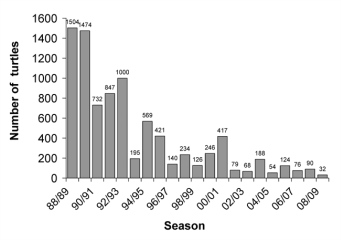 |
| Decline in Leatherback nesting at Costa Rica.,from the leatherback turtle conservation project at Parque Nacional Marino Las Baulas. Source: The Leatherback Trust |
What can be done in Victoria
Leatherback Turtles feeding in Bass Strait carry out their nesting in tropical waters to our north but where they nest is not exactly known because we know very little about their ecology or occurrence in this part of the world. We may be able to raise public awareness to assist in conserving nesting sites, similar to what is being done in Mexico.
Conservation of leatherbacks in our area needs to focus better understanding their ecology and on reducing entanglements with fishing gear.
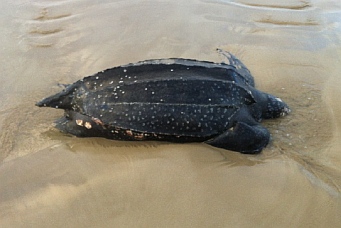 | |
| Leatherback Turtle washed up dead at Waratah Bay 24 Februray 2014 cause of death unknown. Image: Ian Downing |
Key points from questions
- Leatherbacks are part of our Victorian marine ecology but we know very little about them.
- Leatherbacks are good candidates for having tracking devices fitted but there has been little research conducted in our waters. A leatherback was fitted with a device which tracked a migration from Nova Scotia, Canada, to Grande Riviere, Trinidad in 2014. Seaturtle.org - worldwide turtle tracking site
See also: Leatherback Turtle on SWIFFT
Endocrine disturbance in a population of Australian fur seals with a high prevalence of alopecia - Michael Lynch, Head of Veterinary Services, Melbourne Zoo
Michael explained that this study was part of a much broader research project between 2007 and 2011 looking at the status of disease in Australian Fur Seals. Michael acknowledged other members of the study team, T. Keeley, J. P. Y Arnould and R. Kirkwood.
Michael spoke about the location of breeding colonies of the Australian Fur seal which is restricted to areas of Bass Strait. The latest population estimates are around 120,000 with 50% of the total population found at two sites being Lady Julia Percy Island and Seal Rocks.
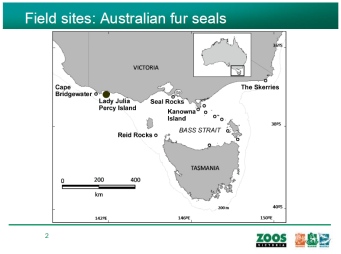 |
The loss of hair (Alopecia) on Australian Fur Seals was first noted by Roger Kirkwood in 2004 when he noticed seals displaying a particular pattern of hair loss between the shoulder blades. The prevalence of this condition increased over subsequent years so further investigations were undertaken.
Michael undertook repeated counts of seals between 2008 and 2010 recording the prevalence of alopecia in the population. He found about 5% of adult females had some degree of hair loss which peaked during the spring/summer period. Juvenile seals (between 1-3 years of age) had a much higher prevalence where up to 25% of juveniles had alopecia. There were no further counts up until January 2014 when juvenile prevalence for that time of the year was slightly less than previously recorded but the prevalence of alopecia in adult females was higher.
Michael rated case severity in which severe and moderate cases showed a very distinct pattern of guard hairs loss whereas in mild cases the loss was more patchy. In severe cases the hair loss could extend right along the trunk up onto the neck and head. It is always bilaterally symmetrical, never on the sides or underside of the seal.
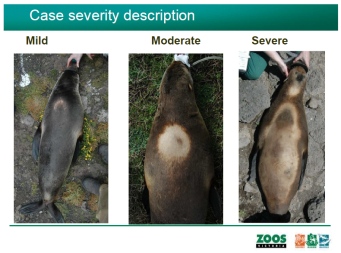 |
Michael tagged a number of seals which had alopecia and monitored them over seasons and years. He was able to see seals which had mild alopecia after the autumn moult had more severe alopecia by the summer. Michael also found that the hair was fracturing off with no sign of itching being observed, or any evidence of inflammation, parasites or dermatophytes. Importantly, he never observed a seal recover from the condition. The condition is rare on male seals or seals under one year of age.
Heat loss
Michael used a thermal camera to measure heat loss. He observed heat loss from alopecic areas in moderate and severe cases. Mild cases showed no heat loss. He also observed that alopecic seals were in poorer body condition compared to other seals. He estimates that up to 50% of juvenile females are affected which equates to around 2500 individuals on Lady Julia Percy island. Although Michael was unable to measure mortality rates of seals suffering this condition he is of the opinion that in severe cases the heat loss would be so great that it would have to increase the mortality risk factor.
Population change
Michael showed a graph of the Australian Fur Seal population measured by the number of pups. The count methodology changed in 1990 from direct count to capture - mark- resight. Up until 2002 there was a general population increase in all populations. But since alopecia was first noted in 2004 there has been a decline with a marked decline since 2009 particularly at Lady Julia Percy Island. Michael pointed out that there may be other oceanographic issues a play and it is not yet conclusive that the decline is caused by alopecia alone.
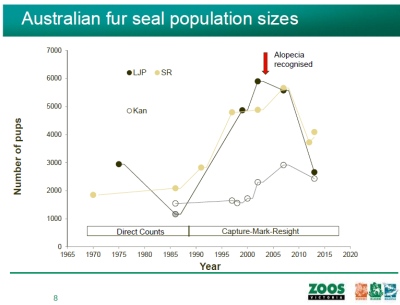 |
Further investigations
Michael had been looking at other effects such as impact on thyroid hormones. He found that in sever and moderate alopecia cases two thyroid hormones were at elevated levels.
Michael also looked at endocrine disruptive chemicals (EDC's), which result from pollution. He found that seals with alopecia had greater concentrations of potentially toxic compounds and greater levels of some DDT's and some PCB's in their fat (which could be concentrated due to overall loss of body weight). Seals with alopecia also had higher levels of lead in their hair and higher levels of mercury in their blood. Michael pointed out that there is insufficient evidence to suggest any one that these pollutants is a direct cause of alopecia. What can be noted is that seals with severe / moderate alopecia have a different toxicological profile compared with unaffected seals.
Summary
Juvenile female seals on Lady Julia Percy Island show evidence of endocrine disruption and had the highest rates of alopecia. Greater sample numbers are required to determine if this is the cause of alopecia.
Key points from Questions
- A project to study prey species and foraging range of seals at Lady Julia Percy Island was submitted but not yet funded. It is unlikely that females were feeding on a different prey and in a different area to males yet females are more prone to alopecia.
- The thyroid hormone is used as an indicator. The presumption is that pollutants are acting as a hormonal analogue which only females have receptors to.
- There are recognised causes of alopecia in other mammals but no recognised toxicological cause of alopecia found in seals.
- *South African Fur seals have not shown the same condition as those on Lady Julia Percy Island where the rates of alopecia are highest.
- The seal population at Cape Bridgewater is considered to be linked to Lady Julia Percy Island population.
Blue whales in the Bonney upwelling - Peter Gill Co-Director, Blue Whale Study Inc.
Peter presented his talk on behalf of himself and Margie Morrice. Peter first began studies into Blue Whales in the Portland area in 1998.
Early whaling off Portland
Peter spoke about the importance of open boat whaling to the early settlement of Portland when whalers hunted Southern Right Whales in the bays to a point where they nearly wiped them out. Early whalers did not have the means to take the larger Blue Whales which are up to 30 metres in length and weigh up to 200 tones. It was only in the 20th Century when larger steam powered vessels were used which had the means to take Blue Whales. During the 1920 and 1930's the population was heavily exploited and nearly decimated off by the 1960's.
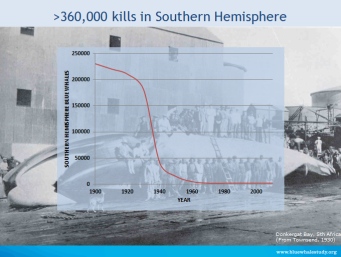 |
| Blue Whales suffered a massive decline in the 1920's and 1930's. By the 1960's they were nearly wiped out. |
Blue Whale habitat
Peter said there are only 18 known areas in the world where Blue Whale are found. A new feeding area was documented in January 2014 near the Cook Strait in New Zealand.
In Australia, Blue Whale feeding aggregations occur off the south-west coast of Western Australia and along the continental shelf waters off south-eastern South Australia and south-west Victoria. The species is actually the Pygmy Blue Whale which is a sub-species, and does not travel to Antarctic waters.
Peter spoke about the Bonney Upwelling which is most pronounced off the waters of Portland where the continental shelf is close to the mainland. The upwelling is driven by south-east winds which drive a current along parallel to the coast. The spin of the earth creates a coriolis effect which drags the warm surface waters out to sea, this water is replaced by upwelling of cool nutrient rich water from deep in the ocean. The upwelling creates conditions which support rich marine life including krill which Blue Whales feed on.
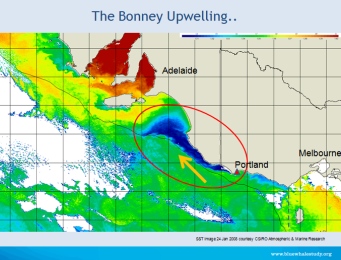 |
| The Bonney Upwelling comprising cool nutrient rich water shown in blue on this thermal image of the ocean off Portland. |
Air surveys
The Blue Whale study has conducted over 150 aerial surveys to locate and count Blue Whales in the study area which stretches from Cape Otway in Victoria to Robe, South Australia. Since 1998 there have been 1500 sightings in the study area. Other sightings have been made along the Tasmanian west coast and scattered through Bass Strait.
Blue Whales arrive in the feeding areas late October to early November, the peak months are February and March, by the end of May they have dispersed northwards.
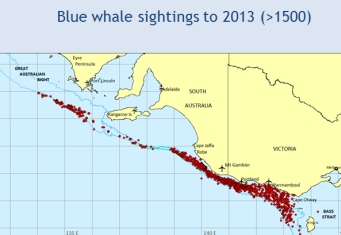 |
Blue Whale feeding
The primary reason for Blue Whales to be in the upwelling is to feed on the species of Krill Nyctiphanes australis which can form swarms on the surface. When feeding, the Blue Whale lunges through the krill taking in about 100 tones of water from which the krill is filtered through the baleen in the whales mouth.
In order to find out more information about feeding behaviour suction caps holding hydrophones were fitted to some whales. This provided valuable data regarding swimming speed, diving and feeding patters. Most krill are taken at the surface but in the Bonney Upwelling krill can also be taken between 30 to 50 metres depth.
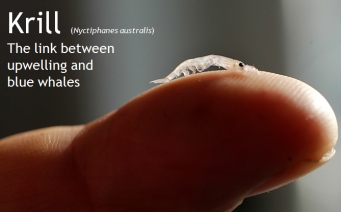 |
|
|
Photo identification
Blue Whales have unique pigment patterns on their flanks which are photographed by the Blue Whale Study to identifying specific whales. This has enabled the collection of information which has proven whales are capable of returning to the same feeding area each year. Photo identification has also shown there is a lot of movement between the Perth Cannon, Western Australian feeding area and the Bonney Upwelling feeding area. Photo identification has also assisted in gaining some insight into associations between individual whales and groupings of whales.
Biopsy
The Blue Whale Study has taken biopsy samples and undertaken genetic studies which has confirmed the species are Pygmy Blue Whales and are the same population as Blue Whales at the Perth Cannon, Western Australia. This also confirms photo identification findings.
Studying previous whale records
Peter spoke about recent information obtained from secret Soviet Union whaling records when in the 1960 around 1000 Blue Whales were illegally taken from southern Australian waters, particularly waters along the northern part of the sub-tropical convergence which is a boundary area between cool Antarctic water and warmer water. This zone is a major feeding area and recent tracking studies have confirmed Blue Whales are returning to these waters.
Population status
Peter cannot say if the Pygmy Blue Whale population is recovering because there is no reliable count of the population. He considers the Bonney upwelling to be a nursery area as about 3% of sightings include calves.
Breeding areas are relatively unknown but from tagging information it appears Blue Whale from southern Australia (Perth Cannon and Bonney Upwelling) can travel to the north of Timor and up into the Banda Sea off Indonesia. More research is needed to determine if the Solomon Islands could also be a breeding area.
Threats
Peter said the main threats are;
Climate change - possible impacts on the global ocean currents and in particular impacts on the Bonney Upwelling. Peter has already observed changes in this system over the last few years when the upwelling did not occur due to persistent warm water where the upwelling previously occurred.
Other concerns; Seismic Surveys - off shore drilling for gas, wave generation systems, fishing gear entanglement, whale watching and the potential for Illegal whaling
Marine biodiversity
Peter said the Bonney Upwelling supports a high diversity of biodiversity. Bait fish are abundant, gannets, mutton birds, storm petrels, penguins, and various species of albatross are seen feeding. The area also contains seals, inshore and off shore species of bottle nose dolphins, common dolphins, pilot whales, killer whales, sheppard's beaked whale, sperm whales, humpbacks, southern right whales, pygmy right whales and the blue whale.
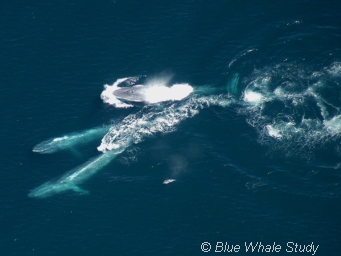 |
| Blue Whales feeding on krill in the Bonney Upwelling. |
Key points from questions
- Blue Whales were never targeted by Australian whalers.
- It is not feasible to apply research results from measuring the diversion of migrating Humpback Whales from seismic air guns to impacts on Blue Whale feeding behaviour.
- Pygmy Blue Whales do not feed in Antarctic waters. Southern Australia is their feeding area.
- There has been an increase in tuna fishers off Portland but there is no evidence this is linked to sea temperature change.
- There was an increase in Southern Right Whale sightings off the Portland coast in 2013 but this does not necessarily mean there are more whales, it could be that the grouping has shifted from another location.
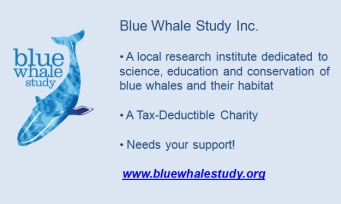 |
Contact: Blue Whale Study
| Leatherback Turtles are part of Victoria's marine biodiversity and Bass Strait is part of their natural feeding range. |
| Leatherback Turtles have suffered a major population decline over the past 20 years. |
| The loss of hair (Alopecia) on Australian Fur Seals was first noted in 2004. Since then there has been a population decline with a marked decline since 2009 particularly at Lady Julia Percy Island. |
| During the 1920 and 1930's the population of Blue Whales was heavily exploited and nearly decimated by the 1960's. |
| The Bonney Upwelling includes continental shelf waters off Portland. It is a major marine biodiversity hot spot and a place where Blue Whales migrate to feed. |
| Climatic conditions can influence the formation of deep, nutrient rich cool water upwelling. If there is no upwelling Blue Whale do not feed in the area. |
| Our marine environment may seem so extensive that it could never be impacted upon but this video conference has provided us with an insight into how humans have decimated some species of whales and turtles and demonstrates our on-going capacity to have a detrimental influence over marine ecosystems. |
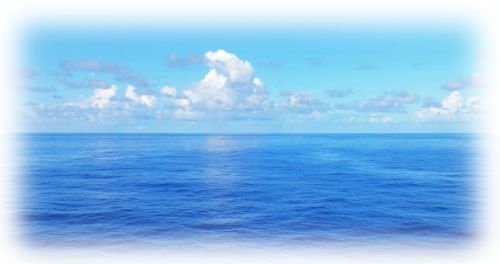 |
- Related topic; SWIFFT seminar Marine biodiversity February 2020
- See the full list of previous video conferences


